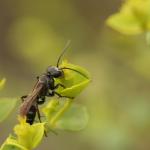An all black species, the abdomen, particularly in the female, with paired spots of silvery-grey pubescence. The posterolateral projections on the propodeum distinguish it immediately from most other British species.
In the British Isles this species is restricted to the Channel Islands.
Overseas it occurs from Europe across to central Asia and in north Africa (Wolf, 1972).
The Channel Islands are, for a number of reasons, excluded from the geographical coverage of the British Red Data book (Shirt, 1987) and the subsequent review (Falk, 1991).
Occurs in open sandy habitats, especially on dunes.
Day (1988) cites records only for June, but suggests it is likely to be active in July and August. It has been recorded on the northern French coast in early September (pers. obs.).
No British data. Gros (1983) recorded a salticid in France, and Wiśniowski (2009) lists several salticid genera as well as Philodromidae and Thomisidae.
This species is fossorial, digging short burrows in the sand. The spider is paralysed prior to nest construction.
No data available.
2019


